The Ultimate Guide to Dynamic Work
The future of work is dynamic
For a long time, we had been anticipating how we work will change—but no one could have predicted it would happen like this. What began as a gradual shift to more remote and flexible environments, driven by digital transformation, demographic transition, changing workforce preferences, and broader macroeconomic trends, suddenly happened overnight.
But this transition was in progress, and inevitable, whether there had been a pandemic or not. Urban unaffordability, global competition for talent, advances in cloud technology, and workforces driven by Millennials and Generation Z are just a few of the factors that have been propelling us toward where we are now, throwing out our old notions of “business as usual” and searching for more flexible and modern alternatives.
Here at Okta, more than 30% of our workforce was remote before COVID-19 forced us all to be, and we had been testing new modes of connecting, communicating, and collaborating across distances well before the world began working from home. We challenged ourselves to understand the changing utility of office environments in a world where freedom and flexibility are top priorities for employees. The result was a new framework that
we call Dynamic Work.
The principle behind Dynamic Work is simple: as our business scales and grows, and as we bring together a global workforce in widely-distributed locations, it’s less critical to maintain large, centralized headquarters where everyone is expected to work. Rather, the concept of the “office” needs to be scaled back: we envision a collection of creative hubs dedicated to in-person touchpoints and experiences. They should be reachable for employees, contractors, customers, and partners who are co-located geographically, and offer opportunities to work onsite, access resources, test products, and gather for company events—but gone are the days when we were all required to be there. Not only does this model grant our employees the flexibility they need to do their best work, but it enables us to build a more diverse hiring pool and bring on amazing candidates from other regions.
Dynamic Work is going to be the standard for Okta today, tomorrow, and beyond, and we want to share this model with other organizations as they adapt to a global, decentralized workforce. We’re firm in our belief that the workplace is far from obsolete—but its design and purpose have changed on a fundamental level, and will continue to do so in our fast-paced world.
As we’re all forced to adapt, we’re looking forward to helping pave the way toward a more productive, flexible, inclusive, and cloud-based future of work.
Dynamic Work defined
A Dynamic Work model allows employees, partners, and contractors to work wherever, whenever, and however they want. We launched Dynamic Work as a pilot program in early 2019. The purpose was to find a way to increase employee empowerment, satisfaction, productivity, and flexibility, while providing us with a broader, more diverse talent pool. At the onset, Dynamic Work enabled employees with more freedom to set their own hours, make their own decisions, and work from wherever they wanted, and we saw a marked uptick in our team members’ sense of wellbeing and work-life balance—and contrary to popular belief productivity, punctuality, and collaboration didn’t suffer in the least. In short, Dynamic Work worked.
- 80% of Okta employees want more WFH flexibility than they had prior to COVID-19
- 81% of Okta employees feel as or more productive working remotely
It’s important to note that Dynamic Work is different— and so much more—than simply working remote or having a distributed workforce. We often hear the terms “remote work” and “distributed work” used interchangeably to talk about organizations operating outside a unified office space. But in fact, they are distinct concepts, as is Dynamic Work.
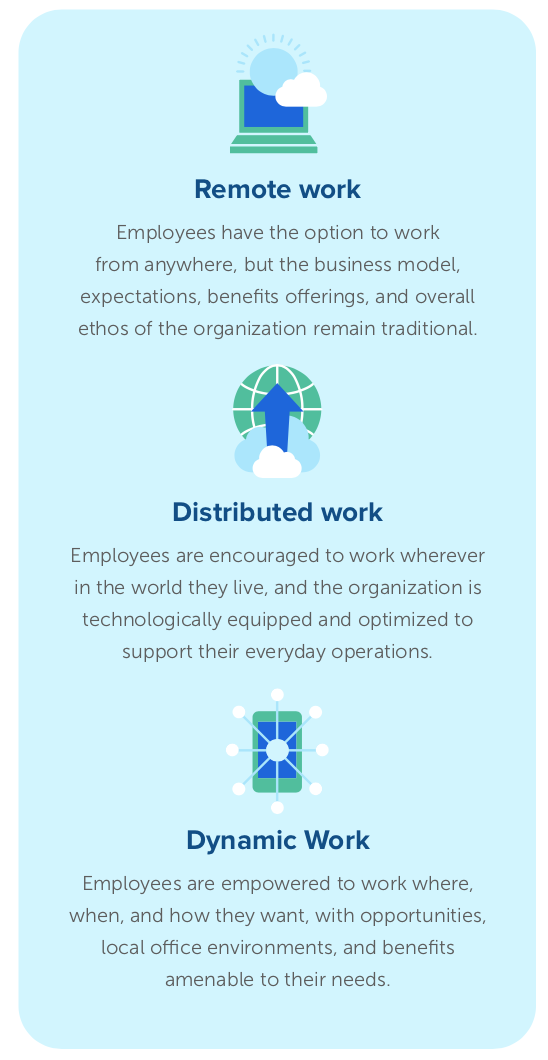
Remote work simply describes the process of working in some location other than the office, whether it’s the home, a coffee shop, or a hotel in a foreign country. Following a remote work model, organizations don’t invest in physical premises where team members, partners, and customers around the world can interact face-to-face.
Several large enterprises have announced that remote work will be an option for their employees from now on, labeling this new policy “remote-first”—but offering flexibility in terms of location should just be the first step. Even if employers embrace remote work, that doesn’t mean they’ll implement the major changes their team members and contractors need in terms of scheduling, compensation, and technology enablement.
Distributed work is a business model in which all aspects of the company are designed to support a dispersed workforce—from the platforms and apps that employees depend on to the expectations around engagement and culture. Sometimes these companies have headquarters or regional offices to provide localized support, but others may be 100% distributed in that they have no physical presence.
A distributed work model embraces long-distance coworking and matches it with employee engagement opportunities, company culture initiatives, and team-building activities geared toward a widespread workforce. But there’s not necessarily flexibility in benefits, nor is there any guarantee that all members of the global team have dedicated, company-owned spaces where they can gather and work.
Dynamic work is all about empowering workforces across the globe with flexibility—working from anywhere, with benefits and opportunities customized to their needs, and the knowledge that the office is also a place they can go to connect, create, and engage as needed. At Okta, we envision our offices as an experience—like an Apple store, where partners and customers can try our products and talk to our experts, and employees can collaborate on their own time, in their own space.
Organizations have often treated their remote employees and contractors as the second-class citizens of the corporate world. Because they were out of sight, they were out of mind as well; and employers acted as though they needed less, and were entitled to less, than their in-office colleagues. A Dynamic Work model finally levels the playing field, ensuring equitability in benefits, programs, opportunities, and culture experiences for the entire workforce.
4 trends driving Dynamic Work
Let’s look at the macroeconomic trends driving the transition to Dynamic Work across all industries and sectors:
-
The cost of living is increasing more rapidly than average salaries, and many people would rather
live outside larger markets. But arduous commutes, or a lack of transit infrastructure, makes that impractical—and takes a heavy toll on quality of life. -
Every company is now a technology company. With more organizations migrating to cloud-based infrastructure, adopting apps for productivity and collaboration, and implementing secure Bring Your Own Device policies, there’s no excuse for them to try and micromanage employees in an office environment.
-
The demographic makeup of the workforce is changing, with Millennials on-track to become the majority by 2025, and Generation Z entering the workforce in greater numbers. Both these groups are digital natives that expect freedom, flexibility, and technological enablement.
-
The COVID-19 pandemic was just one of many possible shocks to the system; emergencies can disrupt entire economies and societies with little to no advance warning, and a Dynamic Work model enables organizations to build in much-needed resilience.
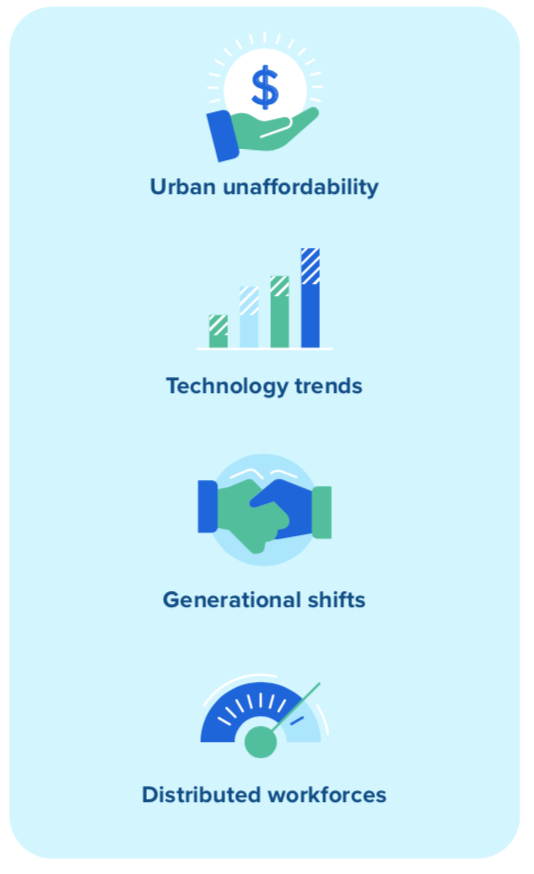
Dynamic Work takes each of these trends into account to create an environment that’s as productive and engaging as it is secure. How can organizations achieve this? A true Dynamic Work model is supported by three essential pillars:
-
Redesign offices to be versatile and needs-based, with the ability to support a variety of working environments that allow for physical distancing.
-
Adopt cloud-based architecture and best-of- breed apps and tools, allowing collaboration and productivity from anywhere.
-
Reinvest in employees and hire the world’s best talent, offering flexibility in where they’re located and the benefits they have.
Here’s how we’ve embraced these core concepts at Okta, along with steps that any organization can take to create a flexible, Dynamic Work environment for their own teams.
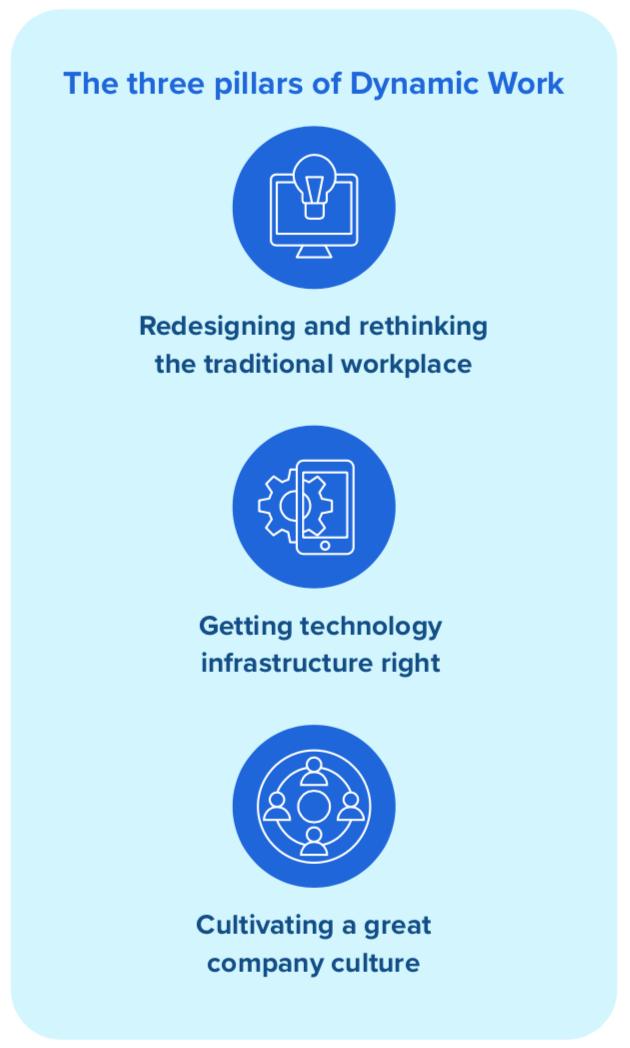
Pillar 1: Redesigning and rethinking the traditional workspace
Companies have been experimenting with office design for decades. We’ve seen everything from cubicles to open-concept floor plans and co-working spaces, yet nothing has proven to be a unanimous, uncontroversial success. It was long overdue for organizations to let their employees choose their own preferred setups— and now, that’s exactly what people all over the world are doing. Once more, organizations need to redefine what it means to be at the “office.”
Naturally, there are several challenges they need to navigate—not just in terms of managing their facilities, but changing their mindsets:
-
Organizations have to negotiate their outdated, traditional norms and expectations around employees being physically present for predetermined working hours.
-
Headquarters and real estate are not only large investments, but important symbols embedded in the organization’s operations, culture, identity, and public perception.
-
Densely-packed, and often open-concept, work environments are poorly-equipped for new norms of physical distancing that will be a long-term legacy of COVID-19.
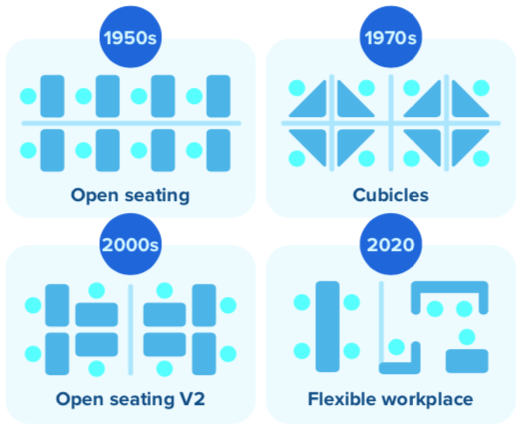
The Dynamic Work approach
Today calls for a new set of success indicators for office spaces and facilities management, so throw traditional metrics out the window. Instead of old-fashioned square footage and employee headcounts, leverage technology to measure when, where, and how team members are interacting with the space, and be responsive to those needs. For the foreseeable future, the number of people allowed to be physically present in the office at once could change unexpectedly, and organizations will need to develop new seat-to-employee ratios.
At a time when a full office represents a health and safety hazard, remote managers and employees are doing everyone a favor. Double down on efforts to keep them engaged, such as regular events across all regions, more robust travel budgets, and increased investments in learning and development.
- 30% of the desks dedicated to employees at Okta HQ are used at any one point of the day
The shift away from traditional office settings has been accompanied by strong rhetoric and bold proposals,
with major players such as Twitter, Shopify, and Facebook announcing plans to make remote work a permanent option. While this may signal to some that physical offices are a thing of the past, there are plenty of compelling reasons why we should keep them around.
When a workforce is 100% remote or distributed, with no or limited possibilities for in-person touchpoints, it can lead to reduced efficiency, cohesion, and morale. Citing a large study published in Harvard Business Review (HBR), McKinsey reports that 43% of remote workers felt that more face time would help them develop deeper relationships with team members, 80% said they would have better relationships with colleagues if they had more frequent team communications, and 84% said that with a remote workforce, team challenges typically dragged on for more than a few days.
The office space of the future should be an optional value-add for employees, rather than a requirement. It should be available on an as-needed basis, allowing them to enjoy flexible schedules and environments in experiential workplaces, regardless of their location in the world.
Armen Vartanian,
Senior Vice President of Global Workplace Services
Dynamic Work, in which the company ensures employees and contingent workers have physical spaces where they can collaborate, even if it’s only occasionally, provides a solution to these problems. That’s why in a different Harvard Business Review article, researchers recommend that employers let their global teams “work from anywhere,” but take advantage of geographic clusters to build culture and collaboration.
Likewise, in analyzing the future of the workplace, Bain & Company posits that they will need to be able to scale up or down on an as-needed basis, and that “executives should get used to thinking about it dynamically.” Leaders need to think critically and creatively about how physical premises can serve their workforce, their customers, and their brand in an age of physical distancing. When done properly, it builds a varied and visionary environment where employees can be inspired, and external stakeholders can experience products and services in person.
Tips for effective Dynamic Work
- Change expectations on how many people come into the office
- Provide various environments
- Gain insights through technology into how employees, contractors, and vendors interact with the space
- Offer face-to-face interactions and the opportunity to build relationships
- Host regular events across all offices in all regions
- Include more robust travel budgets Invest in learning and development
Pillar 2: Getting technology infrastructure right
For companies that had a good handle on their digital transformation initiatives, the recent shift to worldwide distributed work has proven surprisingly seamless. With the right technology in place, business has been able to carry on normally, with no impact on productivity. But it’s not always so simple. For some organizations— such as government agencies, healthcare providers, and others that operate on legacy, on-prem architecture—simply supporting a remote workforce poses significant challenges:
-
To be effective, workforces need numerous apps. These need to be integrated into the IT stack, and each user needs to be provisioned to an account.
-
Legacy and on-premises infrastructure, including custom apps, are difficult for distributed teams to access remotely—and expensive to maintain.
-
A distributed workforce means a distributed network, which can no longer be secured by a traditional perimeter or VPN. To be secure, all users must be untrusted.
To build a framework that puts people first, employers have to see the whole picture—the applications that people need when working remotely, the hardware and services they require onsite, and the overall experience of accessing these resources. Only then can they succeed and scale.
Chris Flynn,
VP, Employee Enablement
The Dynamic Work approach
To ensure your workforce has everything it needs to succeed, invest in a scalable, hybrid IT environment that lets you adopt the cloud-based tools your team expects, and integrate them easily into your existing architecture. Video conferencing, messaging, and document collaboration apps empower your employees, partners, vendors, and contractors to do their best work, wherever they’re located.
Third-party collaborators such as partners, vendors, suppliers, and contractors can extend a company’s workforce by up to 20%. By adopting a Dynamic Work model, organizations can provide these external users with more seamless and secure access to applications.
Apps can also provide a pillar of critical support to the people who support your workforce—your HR, IT, and developer teams. Human capital software can drive efficiencies and enhance employee engagement, while cloud identity solutions can automate time-consuming IT tasks such as provisioning and deprovisioning across the employee lifecycle. They’re also a core component of implementing a Zero Trust security model, in which every access request to come through your system is immediately assessed at the level of individual and device.
Leaders should be paying attention to which platforms and applications are the most critical for their teams to do their best work from anywhere. It’s a trend that we’ve been watching here at Okta; as organizations moved towards more remote work as a result of the COVID-19 pandemic, it painted a clear picture of the top tools that modern workforces require—a picture that we captured in our Businesses @ Work (from Home) report.
-
Adoption of communication and conferencing apps climbed dramatically in March 2020 as workforces moved to remote work; Zoom showed a 110% growth in unique workforce users, RingCentral grew 39%, and Cisco Webex grew 37%. Going forward, these types of applications will remain relevant in keeping a Dynamic Work model connected and productive.
-
Network security and performance tools also saw a notable surge; Palo Alto Networks GlobalProtect saw month-over-month growth of 94%, Cisco AnyConnect grew 86%, and Citrix ADC grew 56%, proving that cloud security plays an important role in the Dynamic Work IT stack. On a related note, Proofpoint Security Awareness training saw gains of 40% during this same time period.
99% of Okta employees report that they have the software they need to be productive while working from home
But it’s important to remember that in a Dynamic Work setting, your infrastructure isn’t restricted to software; rather, hardware and on-site digital and electronic resources are required for a truly technology- enabled workspace. Digital whiteboards and advanced microphones allow effective conferencing and collaboration, while tools such as conductive charging provide convenience and utilization sensors and smart lockers enhance security. Everything should be accessible via mobile—for example, mobile badging for authorization to various on-site spaces and assets, and workforce apps available anytime, anywhere, through the cloud.
On top of that, wayfinding tools are a smart investment for organizations. Employees will want to book resources online before they come to the office, as well as learn who else is working onsite at that time and where they will be located. In a post-pandemic era, this level of foresight will be essential for workforces, as will the freedom to work flexibly and remotely. To this end, having the right hardware and software in place is paramount.
Organizations need to be able to support teams that can work from anywhere, but they cannot compromise security in the process. In the past, this may have presented a challenge, but with modern solutions and a Zero Trust approach, it’s more than possible.
David Bradbury,
Chief Security Officer
Tips for effective Dynamic Work
- Plan for hybrid, in and out of the office
- Invest in cloud-based collaboration tools (e.g. Slack, Box, Okta, Confluence, Zoom, Github)
- Rethink hardware
- Make everything mobile accessible
- Invest in technology-first workplace resources
Pillar 3: Cultivating a great company culture
There’s one reason, and one reason only, why organizations need to make the effort to redesign their office environments and modernize their technology stacks: their people. But truly championing your employees and collaborators requires more than just state-of-the-art offices and best-in-class technology.
From the company events and opportunities that keep them engaged, to the perks and benefits that will keep them healthy, happy, and safe, leaders need to think carefully about how they’ll retain their talent. And you not only need to think about the talent you have today; in a world where you can recruit from anywhere, you need to consider the talent you hope to attract in the near future, and the offerings that will compel them to choose you over your competitors.
All of these factors are determined by a company’s culture. And as anyone in leadership knows, changing the cultural foundations of an organization is no small feat.
-
Modern benefits and incentives haven’t kept up with the needs of the new workforce, but changing these across the entire employee base is a significant undertaking.
-
Likewise, compensation, which has traditionally been based on role and responsibility, now has to be reasonably adjusted for different costs of living in different regions.
- Team-building activities that would normally take place onsite will not be possible to the same extent, and virtual formats will be needed to reach more employees in more places.
In today’s changing workplaces, employee expectations are rapidly evolving. It’s time for people leaders to critically reevaluate the perks, benefits, engagement opportunities, and cultural experiences they provide if they’re going to attract and retain top global talent.
Kristina Johnson,
Chief People Officer
The Dynamic Work approach
There are few things the modern workforce values more than flexibility, and that’s what a Dynamic Work model provides. And not just in terms of location. Employees need autonomy to determine the best times to work, as well as a variety of options for additional benefits, such as fitness and wellness coverage or volunteer opportunities.
Providing an aggregator or “buffet” of perks and benefits enables employees to pick the packages that work best for them and their families. Investing in virtual learning and development opportunities, speakers and sessions, happy hours, and other workplace activities also keeps engagement and cohesion high among the entire team.
The future of the workforce also needs to be diverse, and this is another core focus of Dynamic Work. By making the world your talent pool, and enabling employees
to live and work wherever it makes the most sense for them, modern organizations have a huge opportunity to move the needle on diversity and inclusion—improving decision making, driving innovation, and bringing together groups of people that can speak authentically on behalf of their global customers.
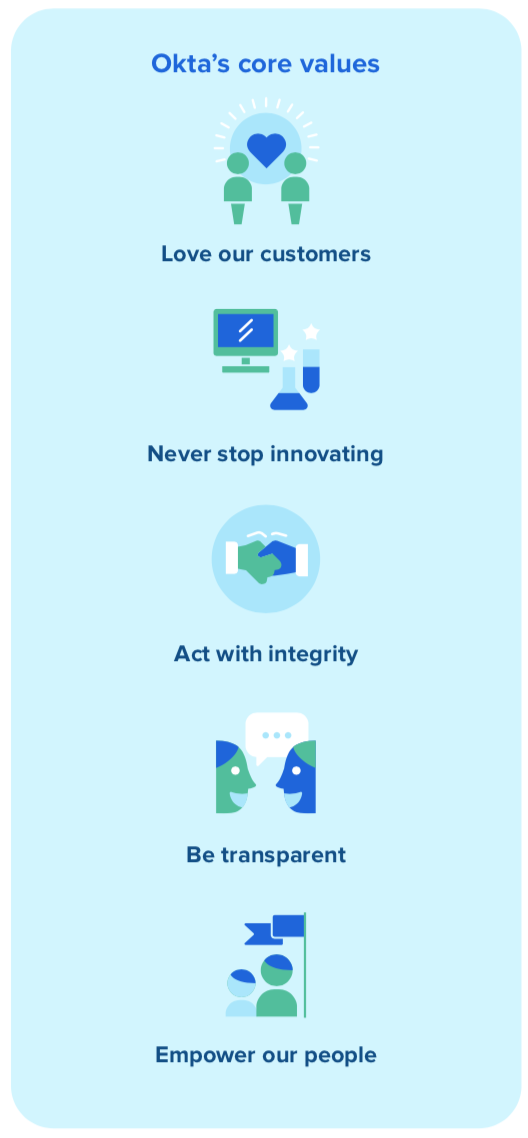
Just how important is it for modern organizations to be flexible? It’s mission-critical. Maintaining a flexible approach to operations, processes, and people management is one of the few things that can provide organizations with the much-needed resilience to withstand major disruptions. Employees likewise demand flexibility in order to remain healthy and productive, and in terms of recruitment, top global talent is going to expect flexibility from top global employers.
In 2019, PwC research showed that the number of people who say flexible work arrangements are a very important factor when considering a new job has increased 24% since 2015. This trend is particularly noticeable among knowledge workers—in the U.S., 96% of professionals say they need flexibility, but according to HBR, only 47% have it. Now they’re taking a stand; a 2018 study commissioned by Spherion indicates that 41% of employees will only accept positions with organizations that offer flexible scheduling and options.
As mentioned previously, flexibility is not only great for workforces but for organizations as a whole—and when they don’t embrace it, there can be consequences. A 2019 study by Gartner found that 55% of organizational redesigns were focused solely on optimizing efficiencies and streamlining operations, and this rigidity resulted in fragility; when sudden disruptions took place, the systems couldn’t respond, pivot, or adapt effectively.
And while it’s critical to continue enabling employees and contractors to work from anywhere, don’t forget to provide gathering spaces for team members and external stakeholders who are geographically co-located. Research from Gallup shows that those who work either 100% remote or 100% in-office are less engaged than their colleagues—and the most engaged employees are those who work three or four days out of office per week.
Finally, building flexibility into policies and culture means playing a bigger role in supporting employees with their financial, physical, and mental wellbeing, and offering benefits that have been customized to their needs— based on their input. With unaffordability, income inequality, and other stress factors trending upwards in recent years, organizations are increasingly functioning as social and public services for their teams. We all care deeply about our people; with a Dynamic Work model, we have a chance to show them just how much.
Tips for effective Dynamic Work
- Allow for flexible schedules
- Create work environments and experiences, regardless of location
- Support with necessary tech and infrastructure
- Offer customizable benefits (e.g. wellness and fitness coverage, volunteer opps)
- Provide personalized and inclusive perks for all
Workforces as dynamic as the future
Disruption—whether social or technological, economic or ecological—is going to continue to impact workforces across the globe in the years to come. To solve these challenges and discover new opportunities, we need workforces as dynamic as the future that awaits them. We can’t predict what will happen a year, five years, or ten years from now—but through thoughtful innovation and decisive transformation, together we can be prepared and forge a path toward better ways of working.
Remote work toolkit
To improve the experience for remote workers, we’ve deployed a number of tools across our customer base. From video/audio conferencing solutions to VPNs, discover the most popular apps for Dynamic Work— and start your free trials today.
Additional resources
For more information about Dynamic Work, and how Okta can help support distributed teams, check out the following:
-
The Future of Work is Dynamic: Going Beyond Distributed and Remote Work (Blog post)
-
Quick Wins and Long-Term Strategies for Remote Work (Webinar)
-
The Integrated Solution You Need to Securely Enable Remote Work at Scale (Datasheet)
-
Securing Remote Work Any Time, Anywhere, at Scale (Blog post)
About Okta
Okta is the leading independent provider of identity for developers and the enterprise. The Okta Identity Cloud securely connects enterprises to their customers, partners, and employees. With deep integrations to over 6,500 applications, the Okta Identity Cloud enables simple and secure access for any user from any device.
Thousands of customers, including 20th Century Fox, Adobe, Dish Networks, Experian, Flex, LinkedIn, and News Corp, trust Okta to help them work faster, boost revenue and stay secure. Okta helps customers fulfill their missions faster by making it safe and easy to use the technologies they need to do their most significant work.
Learn more at: www.okta.com